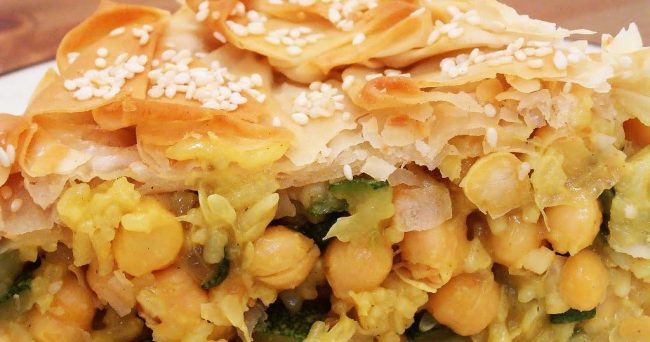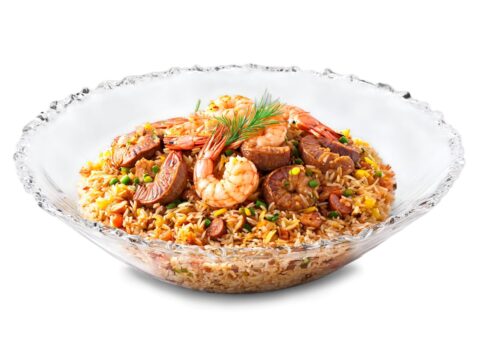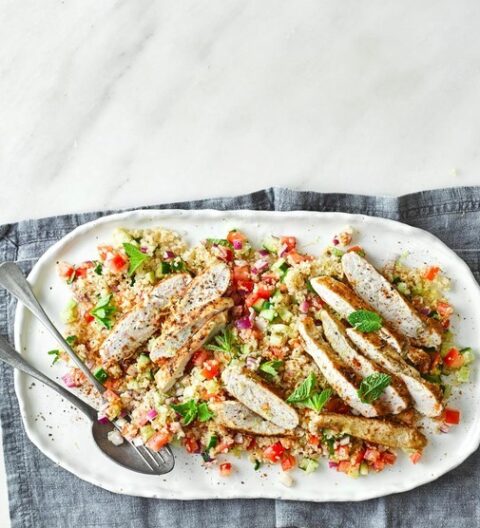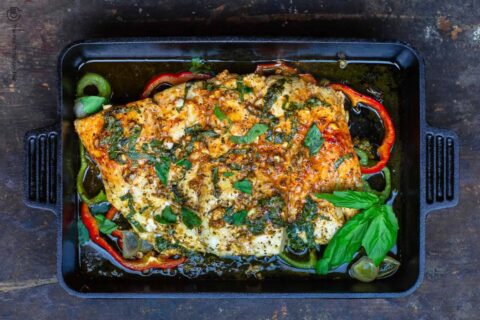
A great combination providing the benefits of olive oil in a diet for heart health.
Updated 4th July 2023
Can I Use Extra Virgin Olive Oil (EVOO) Instead of Vegetable Oil?
If you are curious about using olive oil instead of vegetable oil in cooking, you’re in the right place. Extra virgin olive oil (EVOO) is the best olive oil to choose because it is extracted naturally and doesn’t contain any chemicals or solvents.
The reason why the substitution between extra virgin olive oil (EVOO) and vegetable oil works is due to the similar fatty acid composition. However, what distinguishes olive oil (EVOO) is the presence of polyphenols, which provide health benefits such as decreasing inflammation and reducing the risk of heart disease. While using extra virgin olive oil (EVOO) in cooking is a healthier option, it also has a much richer flavor profile than vegetable oil. It also has the amazing ability to draw out the flavour of your ingredients for a much more fulfilling dish.
Extra Virgin Olive Oil For Cooking
Extra virgin olive oil is widely considered to be the best type of olive oil for cooking. It is made from pure, cold-pressed olives, and has a lower acidity than other types of olive oil. This makes it less likely to smoke or burn when heated, and also gives it a more robust flavour. In addition to being a great cooking oil, extra virgin olive oil also has a number of health benefits. It is rich in antioxidants and monounsaturated fats, both of which have been linked to lower rates of heart disease. It also contains oleocanthal, a compound that has anti-inflammatory properties. For these reasons, many people choose to use extra virgin olive oil when cooking dishes like courgette and chickpea pie.
When it comes to courgette and chickpea pie, extra virgin olive oil adds both flavour and nutrition. The rich taste of the oil enhances the other ingredients in the dish, and its healthy fats help to make the pie more satisfying. In addition, the antioxidants in the olive oil can help to reduce the risk of some chronic diseases. As a result, using extra virgin olive oil when cooking courgette and chickpea pie is not only delicious but also good for your health.
Ingredients
- ½ teaspoon cumin
- 1 teaspoon ground coriander
- ½ teaspoon turmeric
- 1 small onion (finely diced)
- 2 tablespoons Morocco Gold
- 3 plump courgettes
- 125 grams basmati rice
- 500 millilitres vegetable stock
- 500 millilitres vegetable stock
- 100 grams melted butter
- 200 grams filo pastry
Instructions
- Preheat the oven to gas mark 6/200ºC/ 180ºC Fan/400ºF and put in a baking sheet.
- Gently fry the cumin seeds and onion in the extra virgin olive oil until the onion's soft. Add the turmeric and coriander. Dice the courgettes (unpeeled), add them to the onion mixture, and cook on a fairly high heat to prevent the courgettes becoming watery. When they are soft but still holding their shape, add the rice and stir well, letting the rice become well coated in the oil.
- Add the stock 100ml / ½ cup at a time, stirring while you do so. When all the liquid has been absorbed the rice should be cooked, so take it off the heat, stir in the chick peas and check the seasoning.
- Brush the insides of a 22cm / 9 inch springform tin with some of the melted butter. Line the bottom and sides of the tin with 3/4 of the filo, buttering each piece as you layer. Leave a little filo overlapping the sides, and keep 3-4 layers for the top. Carefully put in your slightly cooled filling, and then fold in the overlaps. Butter the last layers of filo and scrunch on top of the pie as a covering.
- Brush with a final coat of butter, and put in the oven for about 20 minutes, or until the filo is golden and the middle hot. Check this by inserting a slim, sharp-bladed knife (or cake-tester). If, when you remove it, it feels hot when you press it against your wrist, the chick pea filo pie is ready
Great Vegies For A Heart Healthy Diet
The courgette, also known as the zucchini, is a variety of cucurbit, which means it’s from the same family as cucumber, squash and melon. It’s one of the most popular vegetables in the squash family, being extremely versatile, tender and easy to cook. It can reach nearly 1 metre (40 inches) in length, but is usually harvested when still immature at about 15 to 25 cm (6 to 10 in). The zucchini, like all squash, originates in the Americas, specifically Mesoamerica. It was then introduced to Europeans in the early 16th century.
This healthy vegetable is packed with minerals such as manganese, folate, and potassium, just to name a few. For vitamins, you can find vitamin A, vitamin C, and a variety of the B vitamins. Zucchini is also a good source of calcium, fiber, and has an abundance of antioxidants. Consuming the combination of these nutrients can help you boost your immunity and maintain optimal health. If you are counting calories, then you should add zucchini to your diet. The veggie is very low in calories. Therefore, you can substitute other portions for a large helping of zucchini and still keep your calorie count low. Since you are taking in fewer calories by eating this summer squash, you can burn off extra calories when you exercise and start to lose weight. Fiber found in zucchini can also help burn fat. With 95% water, this vegetable can also hydrate your body and give you more energy.
Young courgettes can be eaten raw, either shaved into ribbons or finely sliced into a salad. They are delicious dressed simply with chilli, chopped mint, lemon and of course withextra virgin olive oil. You can sauté, roast, grill or barbecue courgettes, or add them to cakes for a sweet treat. Larger courgettes can be stuffed
Chickpeas, or garbanzo beans, are a type of legume. The most common type has a round shape and a beige colour but other varieties are black, green, or red. Their nutrients have a range of health benefits, almost as wide ranging as extra virgin olive oil and are therefore a great companion for a healthy diet.
For people who are cutting down on meat consumption, a dish of chickpeas and rice, for example, can contribute a significant amount of protein to the diet. A cup of chickpeas provides almost one-third of an adult’s daily protein needs. This chick pea filo pie make a great alternative.
The courgette, also known as the zucchini, is a variety of cucurbit, which means it’s from the same family as cucumber, squash and melon. It’s one of the most popular vegetables in the squash family, being extremely versatile, tender and easy to cook. It can reach nearly 1 metre (40 inches) in length, but is usually harvested when still immature at about 15 to 25 cm (6 to 10 in). The zucchini, like all squash, originates in the Americas, specifically Mesoamerica. It was then introduced to Europeans in the early 16th century.
Young courgettes can be eaten raw, either shaved into ribbons or finely sliced into a salad. They are delicious dressed simply with chilli, chopped mint, lemon and of course withextra virgin olive oil. You can sauté, roast, grill or barbecue courgettes, or add them to cakes for a sweet treat. Larger courgettes can be stuffed
Chickpeas, or garbanzo beans, are a type of legume. The most common type has a round shape and a beige colour but other varieties are black, green, or red. Their nutrients have a range of health benefits, almost as wide ranging as extra virgin olive oil and are therefore a great companion for a healthy diet.
For people who are cutting down on meat consumption, a dish of chickpeas and rice, for example, can contribute a significant amount of protein to the diet. A cup of chickpeas provides almost one-third of an adult’s daily protein needs. This chick pea filo pie make a great alternative.



